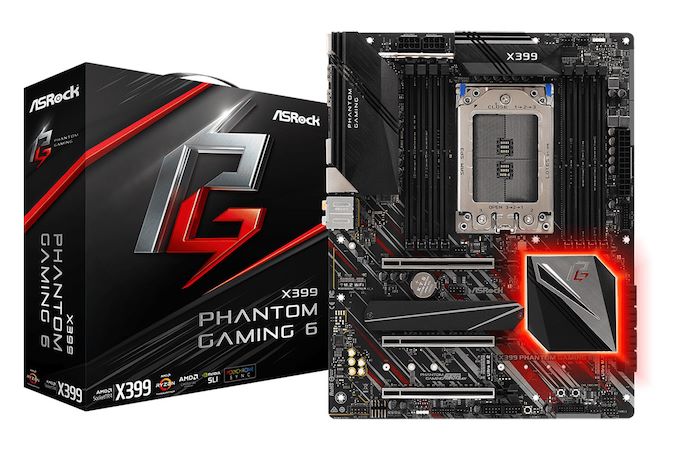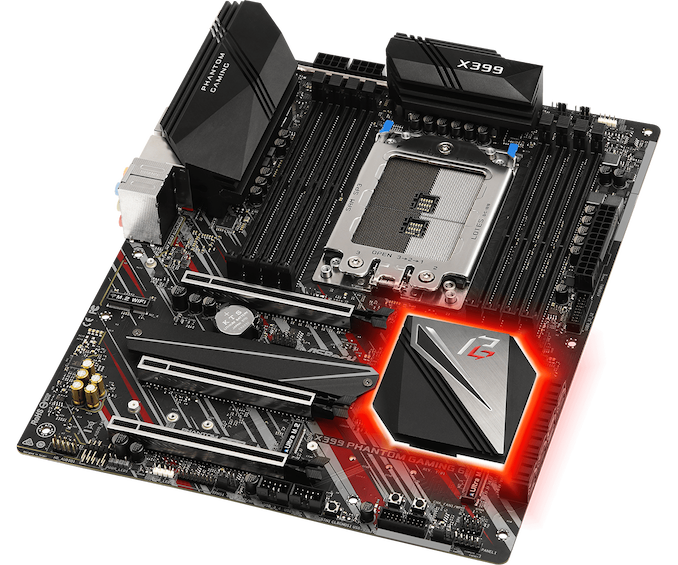The ASRock X399 Phantom Gaming 6 Motherboard Review: $250 Sixteen Core Stunner
by Gavin Bonshor on March 12, 2019 10:00 AM EST- Posted in
- Motherboards
- AMD
- ASRock
- ATX
- ThreadRipper
- X399
- TR4
- 2950X
- 2.5G
- Phantom Gaming 6
ASRock X399 Phantom Gaming 6 Conclusion
The ASRock X399 Phantom Gaming 6 is an ATX sized offering with the aims to dominate the entry-level segment of Threadripper motherboards. It has an MSRP of $250, which puts it $30 cheaper than the GIGABYTE X399 Aorus Pro ($280) and $70 lower than the ASRock X399 Taichi ($350). On paper, the ASRock X399 Phantom Gaming 6 offers more in terms of feature set than the GIGABYTE X399 Aorus Pro.
ASRock also enabled this motherboard with a few unique features, such as 2.5 gigabit ethernet, and expanded on common features, like triple M.2 for storage and triple x16 for add-in graphics. Its biggest caveat is in the CPU support list, with the ASRock X399 Phantom Gaming 6 offering support for Threadripper processors with a TDP up to 180 W. The power delivery is actually quite good for the 180W CPUs, running in a 6+2 configuration which is spearheaded by an Intersil ISL69147 7-phase PWM controller and six Intersil ISL99227 power stages that have direct mental contacts with a large 60 A rating. This kind of setup is fine for 180 W processors under optimal thermal conditions, but it’s not extensive enough for 250 W and the decision to limit it to 180 W is a good call. That gives the ASRock X399 Phantom Gaming 6 a unique position against the other competitors in that more useful and premium features can be added for users who opt for CPUs such as the Threadripper 2950X.
Performance in our test suite and in overclocking the Ryzen Threadripper 2950X processor proved competitive and shows that the X399 Phantom Gaming 6 is no slouch. The biggest win for the Phantom Gaming branded model was in DPC latency with a better than average score than the rest of the pack previously tested. Our CPU performance and gaming performance results we’re consistent with what was expected. The only real negative came in POST time with the second worst result on the X399 platform. We managed to achieve an overclock of 4.2 GHz with 1.425 V on the CPU Vcore and didn’t experience too much in the way of VDroop; it undervolted our CPU by just under 0.02 V. This is acceptable and didn’t cause any issues regarding the stability of the overclock.
Calling a $250 Threadripper compatible motherboard ‘budget’ is a bit of a stretch, but ASRock has a highly competitive and well-positioned model in the X399 Phantom Gaming 6. The design is modern and neutral and users looking for RGB will appreciate the two RGB headers and single addressable RGB header; the ASRock Polychrome Sync RGB software is one of the best utilities on the market as far as motherboards go. For users looking for a cheaper and feature-rich foundation for Threadripper based system and like gaming features such as 2.5 GbE NIC, the ASRock X399 Phantom Gaming 6 adds to a small X399 selection, but with something very appealing and offers good value. Workstation users looking to build a Threadripper 2990WX based system aren’t likely to grumble at $100 more for a beefier motherboard, and ASRock’s decision to limit CPU power to 180 W isn’t a detriment, but actually focuses cost where it needs to. At the price point, the ASRock X399 Phantom Gaming 6 is a serious board for the Threadripper entry level market and is certainly one to be considered.
Other AnandTech Ryzen Threadripper Coverage
- The ASRock X399 Taichi Motherboard Review: Cost-Effective Threadripper
- The MSI MEG X399 Creation Motherboard Review: The New 16-Phase Shark In Town
- The ASUS X399 ROG Zenith Extreme Motherboard Review: Top Tier Threadripper
- GIGABYTE's X399 Aorus Extreme: The Threadripper 2 Halo Motherboard
- The ASRock X399 Professional Gaming Motherboard Review: 10G For All
- The GIGABYTE X399 DESIGNARE EX Motherboard Review












22 Comments
View All Comments
drajitshnew - Tuesday, March 12, 2019 - link
Thanks for this review, this mobo has some very good design choices. Is there some way the post latency can be improved in THIS board.EliteRetard - Tuesday, March 12, 2019 - link
On a similar note, why is it listed as "Non-UEFI POST Time"? Are you actually disabling UEFI and going with a legacy BIOS for post time? Why, and how does that affect post time? I imagine anybody using this board will want to use UEFI.I am glad that POST time is being measured though, it's an important metric for me and many people I build computers for. Some people might think it unimportant, but when POST vary so drastically the differences are very tangible. Most of the people I build computers for also directly correlate bootup times to the performance of the machine (no matter how many times I try to explain it). I know I still would never accept a MOBO with a 30sec POST time.
GreenReaper - Tuesday, March 12, 2019 - link
They may mean "non-Graphical", but still using UEFI under the hood. It's unlikely to have display acceleration, so it takes extra CPU time to draw fancy pictures (as I found when using graphical console modes on my Linux microserver - 8-bit and 16-bit were proportionately faster than 24-bit).gavbon - Wednesday, March 13, 2019 - link
You can't disable UEFI as UEFI and BIOS are both types of firmware and in themselves, they aren't the same. With the UEFI firmware and CSM, it can emulate or pretend to POST like a non-UEFI BIOS. This is a more consistent way of doing things to show performance across a range of boards etcclose - Thursday, March 14, 2019 - link
But it would help to tell us what the boot time is with "optimized defaults" so to speak. I mean it's great if you can "show performance across a range of boards" but why mention only how long it take is non-UEFI mode for comparison? Why not also in UEFI mode? Is that comparison not useful? Or is the board always in non-UEFI mode?kobblestown - Wednesday, March 13, 2019 - link
Yes, this MB has some good design choices. For the price. I would have preferred to have either a 10G Ethernet adapter or a PCIe2.0x4 slot, e.g. where the heatsinked M.2 slot is (and the battery should be moved somewhere else. In my opinion 10G is taking off (I already have a direct 10G link between my X399 and my server) and will soon be within reach for most consumers. Having to occupy a x16 slot for a 10G adapter sends shivers down my spine. Plus, you could also wish to use a 4x4 bifurcation adapter board to install more nvme SSDs (3 is sometimes not enough) and then you'll be left with a single slot for a GPU.As for the POST times, I hope they can get them down to the other X399 boards. I see no reason why it should be twice longer. I have the Asrock X399 Professional Gaming and POST is already excruciatingly slow. Probably the panoply of PCIe devices is to blame (lspci shows more than 60 devices apart from the user-installed ones!)
Kevin G - Tuesday, March 12, 2019 - link
I think this needs to be edited a bit for clarity on page 1:"The audio PCB is separate from the rest of the PCB"
There is no separate audio PCB from the pictures I see as implied by that statement. I think the intent was to read 'the audio circuitry is separate from the rest of the PCB'.
Kevin G - Tuesday, March 12, 2019 - link
Two more on page 4:"For the start of our Z390 reviews" I think should read "Since the start of our Z390 reviews"
Also...
"Many due to..." I thank you missed a word there. ;)
Ryan Smith - Wednesday, March 13, 2019 - link
Thanks!lmcd - Tuesday, March 12, 2019 - link
*separate PCB layerwhich is in fact true (or at least their marketing claims as much)